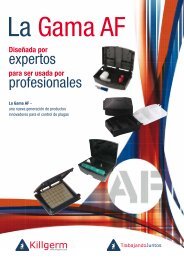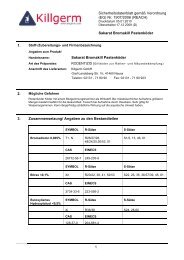Safety Data Sheet Woodworm Killer - Pestcatcher Pest Control
Safety Data Sheet Woodworm Killer - Pestcatcher Pest Control
Safety Data Sheet Woodworm Killer - Pestcatcher Pest Control
Create successful ePaper yourself
Turn your PDF publications into a flip-book with our unique Google optimized e-Paper software.
1 Identification of the preparation<br />
and the supplying Company<br />
<strong>Safety</strong> <strong>Data</strong> <strong>Sheet</strong> <strong>Woodworm</strong> <strong>Killer</strong><br />
<strong>Woodworm</strong> <strong>Killer</strong>. A concentrated insecticide for remedial wood treatment.<br />
Killgerm Chemicals Ltd, Denholme Drive, Ossett, West Yorkshire, WF5 9NA.<br />
Tel: +44 (0)1924 268450 Fax: (0)1924 265033 Email: technical@Killgerm.com<br />
2 Hazards identification Xn_ R65_ Harmful: May cause lung damage if swallowed.<br />
N_ Dangerous for the environment. R51/53_ Toxic to aquatic organisms, may cause long-term adverse effects in<br />
the aquatic environment.<br />
3 Composition and information on<br />
ingredients<br />
Cypermethrin technical<br />
Wood-penetrating solvents<br />
Emulsifiers<br />
Page 1 of 2 SDS: <strong>Woodworm</strong> <strong>Killer</strong> REVISION NO. 2 Issue date: FEB 2010<br />
-<br />
-<br />
-<br />
0.50%w/w Xn. R20/22. N. R50/53.<br />
93.50%w/w Xn. R65. R66. R67. N. R51/53.<br />
6.0%w/w F. Xn. R10. R20/22. R36/38. R41. R53.<br />
4 First Aid measures Ingestion: DO NOT INDUCE VOMITING. GET MEDICAL ATTENTION. Wash out mouth<br />
with water. If spontaneous vomiting has occurred keep patient at rest, ensuring<br />
airways are clear and phone for an ambulance with oxygen facilities.<br />
Inhalation: Remove to fresh air. Loosen clothing at neck. Keep at rest. Get medical<br />
attention.<br />
Skin contact: Remove contaminated clothing. Wash off with soap and water. Get medical<br />
attention.<br />
Eye contact: Flush thoroughly with eye wash solution or clean water for 15 minutes. Get<br />
medical attention.<br />
Advice to doctor: Contains pyrethroid in petroleum distillate.<br />
5 Fire-fighting measures Extinguishers: Use dry powder or foam fire extinguishers. DO NOT USE WATER JET.<br />
Toxic fumes will be evolved in a fire.<br />
Self-contained breathing apparatus should be worn by fire fighters.<br />
6 Accidental release measures Spillage (containment and<br />
disposal):<br />
7 Handling and storage<br />
Precautions in use:<br />
Wear appropriate PPE. Absorb in sand, earth or proprietary product, shovel<br />
into marked container and contact a waste disposal firm or supplier for<br />
disposal advice. Wash area with water.<br />
This product is subject to the Food and Environment Protection Act, 1985 and<br />
The <strong>Control</strong> of <strong>Pest</strong>icides Regulations 1986 made under it. The product must<br />
be used and stored only in accordance with the product label.<br />
FOR USE ONLY AS AN INSECTICIDE.<br />
The (COSHH) <strong>Control</strong> of Substances Hazardous to Health Regulations 2002<br />
may apply to the use of this product at work.<br />
FOR USE ONLY BY PROFESSIONAL OPERATORS. Engineering control of<br />
operator exposure must be used where reasonably practicable in addition to<br />
the following items of personal protective equipment. Wear suitable protective<br />
clothing, gloves and eye/face protection.<br />
AVOID EXCESSIVE CONTAMINATION OF COVERALLS AND LAUNDER<br />
REGULARLY.<br />
Do not breathe spray. Otherwise wear respiratory protective equipment and<br />
eye protection. (See HSE Guidance Booklet HS(G)53: “The Selection, Use<br />
and Maintenance of Respiratory Protective Equipment – A Practical Guide”).<br />
However, engineering controls may replace personal protective equipment if a<br />
COSHH assessment shows they provide an equal or higher standard of<br />
protection.<br />
DO NOT CONTAMINATE FOODSTUFFS, EATING UTENSILS OR FOOD CONTACT<br />
SURFACES.<br />
COVER WATER STORAGE TANKS before application.<br />
THIS MATERIAL AND ITS CONTAINER must be disposed of in a safe way.<br />
WHEN USING DO NOT EAT, DRINK OR SMOKE.<br />
UNPROTECTED PERSONS AND ANIMALS SHOULD BE KEPT AWAY FROM<br />
TREATED AREAS FOR 48 HOURS OR UNTIL SURFACES ARE DRY.<br />
REMOVE OR COVER ALL FISH TANKS AND BOWLS before application.<br />
DO NOT CONTAMINATE watercourses or ground.<br />
ALL BATS ARE PROTECTED UNDER THE WILDLIFE AND COUNTRYSIDE ACT<br />
1981. BEFORE TREATING ANY STRUCTURE USED BY BATS, CONSULT ENGLISH<br />
NATURE, SCOTTISH NATIONAL HERITAGE OR THE COUNTRYSIDE COUNCIL FOR<br />
WALES.<br />
DO NOT USE ON BEEHIVES OR BEEKEEPING EQUIPMENT.<br />
AVOID ALL CONTACT WITH PLANT LIFE.<br />
Avoid contact with skin and eyes. WASH ANY CONTAMINATION from skin or<br />
eyes immediately. WASH HANDS AND EXPOSED SKIN before meals and after<br />
use. If swallowed, do not induce vomiting: seek medical advice immediately<br />
and show the container or label. Use only in well ventilated areas.<br />
VENTILATE TREATED AREAS THROUGHLY after application.<br />
ALWAYS READ THE LABEL. USE PESTICIDES SAFELY.<br />
Avoid release to the environment. Refer to other sections of this safety data<br />
sheet. To avoid risks to man and the environment, comply with the<br />
instructions for use.<br />
Avoid use of the product on UPVC, PVC, PE, neoprene and polystyrene<br />
surfaces where retention of the smooth “unfogged” appearance of the material<br />
is desirable. Spot test these surfaces and marble, for liability to stain prior to<br />
treatment. Do not use on or near carpets or white aluminium fabrications.<br />
Take precautions against run-off from treated surfaces contacting any of these<br />
substances. Other building material may suffer staining/colour changes if runoff<br />
is allowed to trickle over them. Take precautions to prevent this happening.<br />
Keep away from sources of ignition- No smoking.<br />
Keep out of the reach of children.
8 Exposure controls and personal<br />
protection<br />
Storage and transport<br />
precautions:<br />
<strong>Safety</strong> <strong>Data</strong> <strong>Sheet</strong> <strong>Woodworm</strong> <strong>Killer</strong><br />
Keep away from food, drink and animal feeding stuffs.<br />
Keep only in the original container. Keep container tightly closed. KEEP IN A<br />
SAFE PLACE.<br />
PPE Item In Use Spillage<br />
Respirator If required, half mask to EN140 with<br />
AP class filter to EN141 to required<br />
protection factor.<br />
Gloves Unlined synthetic rubber (nitrile) /PVC<br />
gloves to EN374 (300mm length).<br />
If required, half mask to EN140 with<br />
AP class filter to EN141 to required<br />
protection factor.<br />
Unlined synthetic rubber (nitrile)/PVC<br />
gloves to EN374 (300mm length).<br />
Overall Coverall Type 5/6. Coverall Type 4.<br />
Goggles/ Face shield Face shield to EN166 when handling<br />
the concentrate. Goggles to EN166 if<br />
required.<br />
Face shield to UN166.<br />
9 Physical and chemical properties Appearance: Straw-coloured liquid.<br />
S.G @ 15.6ºc: 0.860<br />
Flash point: 66ºC<br />
Flammability: Will burn and may render other materials more readily combustible if spilled<br />
onto them.<br />
Solubility in water: Forms milky white emulsions.<br />
10 Stability and reactivity Stable preparation, not reactive. Toxic fumes evolved in a fire.<br />
11 Toxicological information Routes of entry/symptoms of contact:<br />
Inhalation: Irritating to lungs.<br />
Skin and eyes: Irritating.<br />
Ingestion: Hazardous if ingested in large quantities. Main hazard of swallowing the<br />
product arises from any consequent aspiration into the lungs which may cause<br />
chemical pneumonitis.<br />
Symptoms of contact: A wide range of effects including irritation, coughing, muscular spasms, tingling<br />
of skin and twitching.<br />
12 Ecological information Preparation is classified as (N) Dangerous for the Environment. Toxic to aquatic organisms, may cause longterm<br />
adverse effects in the aquatic environment.<br />
Extremely dangerous to fish. Do not contaminate ponds, waterways or ditches with the chemical or used<br />
container. Remove/cover fish tanks or bowls before spraying.<br />
Avoid all contact with plant life.<br />
Do not use on beehives or beekeeping equipment.<br />
13 Disposal considerations Empty containers: Do not re-use. Empty completely – wash out into sprayer. Dispose of as below.<br />
Unused/recovered materials:<br />
Tank washings:<br />
Contaminated PPE: }<br />
Do not dispose of in domestic refuse.<br />
Treat as controlled waste.<br />
Contact supplier for advice.<br />
14 Transport information UN. NO. 3082. Class 9. Packing Group III.<br />
Marine Pollutant “P”.<br />
Environmentally hazardous substance, liquid. N.O.S.<br />
Contains 33.5% alkyl benzenes.<br />
15 Regulatory information • This preparation has been classified in accordance with The Chemicals (Hazard Information and<br />
Packaging for Supply) Regulations 2002: CHIP 3. These implement the Dangerous Preparations<br />
Directive- 99/35/EC. This <strong>Safety</strong> <strong>Data</strong> <strong>Sheet</strong> complies with CHIP 3 requirements and the <strong>Safety</strong><br />
<strong>Data</strong> <strong>Sheet</strong>s Directive 91/155/EEC (as amended by Directives 93/112/EC and 2001/58/EC).<br />
• Refer to other relevant measures such as the Health and <strong>Safety</strong> at Work etc Act 1974 and the<br />
COSHH regulations and guidance.<br />
• The information contained in this data sheet does not constitute the user’s own assessment of<br />
workplace risks as required by legislation.<br />
• Hazard classification. Xn_ R65_ Harmful; may cause lung damage if swallowed. N. Dangerous<br />
for the environment. R51/53_ Toxic to aquatic organisms, may cause long-term adverse effects in<br />
the aquatic environment.<br />
• <strong>Safety</strong> phrases- see paragraph 7.<br />
16 Other information Use only in accordance with label instructions.<br />
Ingredient classification data Xn- harmful. F- Flammable. N- Dangerous for the environment. R20/22- Harmful by inhalation<br />
and if swallowed. R65- Harmful: may cause lung damage if swallowed. R66- Repeated exposure may cause skin dryness or<br />
cracking. R67- Vapours may cause drowsiness and dizziness. R36/38- Irritating to eyes and skin. R41- Risk of serious<br />
damage to eyes. R50/53- Very toxic to aquatic organisms, may cause long-term adverse effects in the aquatic environment.<br />
R10- Flammable. R51/53- Toxic to aquatic organisms, may cause long-term adverse effects in the aquatic environment.<br />
Observe statutory conditions of use on the label.<br />
Always read the label. Use pesticides safely.<br />
This data sheet does not constitute the user’s own assessment of workplace risks as required by legislation.<br />
The information contained within this data sheet is strictly for general guidance only and should not be relied upon over and<br />
above this. This data sheet is intended to provide general health and safety guidance on the handling, storage and<br />
transportation of the preparation. The information provided in this data sheet is accurate at the date of publication and will be<br />
updated as and when appropriate. No liability will be accepted by Killgerm Chemicals Limited for any loss, injury or damage<br />
arising from any failure to comply with the information and advice contained within this data sheet and/or failure to comply with<br />
the manufacturer’s guidelines, product label data and any associated technical usage literature.<br />
Incorporates the REACH requirement changes to safety data sheets.<br />
Page 2 of 2 SDS: <strong>Woodworm</strong> <strong>Killer</strong> REVISION NO. 2 Issue date: FEB 2010
















